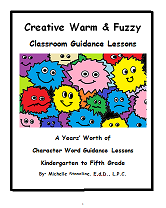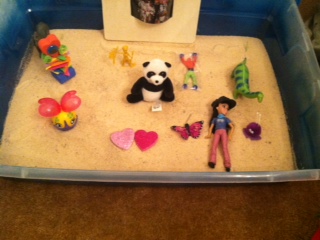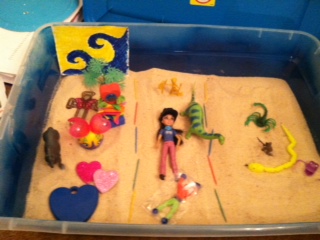Sand Tray Theory and Sand Tray Therapy Final- Student #5
by Student #5
(Sand Tray Therapy Class Student)
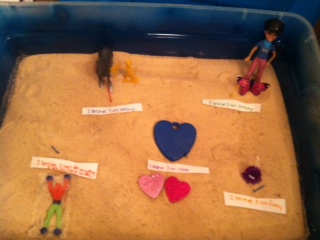
Sand Tray Theory and Sand Tray Therapy Final- Student #5
Self Esteem Issue with Adolescent Girls and the Sand Tray in Therapy
Rational: Self-esteem can be explained simply as how much a person likes him or herself. Adolescents have varying levels of self-esteem, which appears to be influenced by such factors as gender, ethnicity, and social class; and can also vary within an individual (www.human.cornell.edu). Research has found that satisfaction with physical appearance is a large component of self-esteem, and adolescent girls have greater dissatisfaction with physical appearance than do boys (Harter, 1990, 1999). The results of low self-esteem can be temporary, but in serious cases can lead to various problems including depression, anorexia nervosa, delinquency, self-inflicted injuries and even suicide. Self-esteem is related to school performance and delinquency (Harter, 1990, 1999). During adolescence many young girls struggle with their self-esteem causing them to feel bad about themselves.
Shen and Armstrong (2008) conducted a study to test the effectiveness of sand tray therapy on adolescent girls with low self-esteem. The effectiveness of sand tray therapy was examined using a pretest-posttest control group design with young adolescent girls identified as having low self-esteem. The results of their study revealed statistically significant differences between participants in the treatment and control groups in self-esteem. Those that participated in the self-esteem sand tray had in increase in self- esteem. My Theory aims to combine the positive effects of sand tray therapy with self esteem activities designed to increase adolescents' self-esteem by helping them to feel good about themselves in general. The following activities are directive sand tray activities.
Sand Tray Therapy Lesson Plan 1:
In Ethiopian culture the lion of Judah represents Strength. This lion is a symbol of the Emperor of Ethiopia. The Emperor of Ethiopia was known as the "Conquering Lion of Judah,” due to having defeated many of the nation’s enemies during his reign.
Explanation: This sand tray activity aims to help establish a child’s identity and strengthen it. This is helpful for children who have lost sight of who they are.
Materials: sand tray, sand, miniatures, markers and strips of paper.
Directions:
1.) Have strips of paper handy with sentences that need to be completed. Each sentence will begin with “I believe…” example “I believe my strong points are…..” or “I believe my family is…..”
2.) Allow the child to pick the sentences that they would like to complete or they can come of with their own.
3.) Have the child place the completed sentences into the sand tray along with miniatures to coincide with each sentence.
4.) Allow the child to sit with the tray.
5.) Discuss the child’s beliefs being sure to be non judgmental
6.) Help the child to understand that beliefs are what help to make them what they are and that everyone has a different set of beliefs.
Sand Tray Therapy Lesson Plan 2:
In 2009 Ethiopia adopted a new symbol on their flag which is a pentagram. A pentagram usually has strokes through the center and has 5 points. The emblem is intended to represent both the diversity and unity of the country.
Explanation: This sand tray activity aims to promote self-esteem and to emphasize all of the different and positive attributes of the child that helps make them the great person that they are. This activity is great for girls off all ages.
Materials Picture frame, picture of the client, sand tray, miniatures, glitter and materials to decorate picture frame.
Directions:
1.) Ask the client to walk around the room and select miniatures that they feel best represent themselves.
2.) Have the client sit with the sand tray and reflect on it
3.) Ask the client to identify what each miniature represents in relation to themselves
4.) Have the client remove and miniatures that they feel to be negative attributes about themselves.
5.) Ask the client for permission to take a picture of them and place the picture into a wooden frame
6.) Allow the child to decorate the frame and place it into the sand tray
7.) Once complete allow the child to sit with the tray and discuss how they are unique while pointing out all of the positive things about themselves that they have placed in the tray.
8.) Allow the child to keep that miniature that represents their favorite thing about themselves. Instruct the child to hold this miniature when they began to think negative or unhappy thoughts about themselves as a reminder of how great they are.
Sand Tray Therapy Lesson Plan 3:
Explanation: This sand tray activity aims to promote sharing of the child’s values and perception of what is important in life. This can be used as an activity to assist in building positive self-esteem in girls of all ages.
Materials, sand tray, sand and miniatures
Directions:
1.) Have the child separate their sand tray into three sections.
2.) Have the child select miniatures of their choice,
3.) Instruct the child to separate the miniatures into three sections from what the feel to be very important, important and not important.
4.) Once complete ask the child to add take away or change miniatures if they feel necessary. Explain to the child that I does not matter if some sections of their tray ore fuller than others or even empty, as long as they have place the miniatures in the group that they feel is right.
5.) Have the child sit with their tray and discuss the miniatures that have been placed into each pile and discuss why they have placed these items in the piles that they did. As you go along, emphasize how that child’s responses are important and unique.
References
Harter. S., (1990). Identity and self-development at the threshold: The developing adolescent (pp. 352-387). Cambridge, MA: Harvard University Press.
Shen. Y., Armstrong. S., (2008). Impact of Group Sandtray Therapy on the Self-Esteem of Young Adolescent Girls. Journal for Specialists in Group Work. v33 n2 p118-137
Adolescent Self-Esteem June 2003 http://www.actforyouth.net
Hobday A & Ollier K.(2005) Creative Therapy with Children and Adolecents Atascadero, CA: Impact publishers Inc
Disclaimer: This website and its content is intended for trained licensed mental health professionals and school certified mental health professionals to use for their clients / students at their own discretion.
*If you ignore the disclaimer above are using these techniques on yourself and you feel any discomfort or upset it is highly suggested that you seek out a licensed mental health professional immediately.
"Beyond Art Therapy" is the concept from Dr. Stangline that combines all creative fields in therapy. It is not the traditional "art therapy" but goes beyond to include sand tray therapy, play therapy, mindfulness, meditation, color therapy, cognitive behavioral therapy, and a vast majority of other therapies.
For any other type of mental health emergency call your local 911 / Police Number immediately.
Dr. Stangline does not offer advice / suggestions to anyone who is not a professional mental health provider, or a student who is studying this field and has questions about mental health programs of study.
See our Exciting Selection of eBooks:
Award Winning:
Creative Counseling 101 eBook
Our Best Seller!
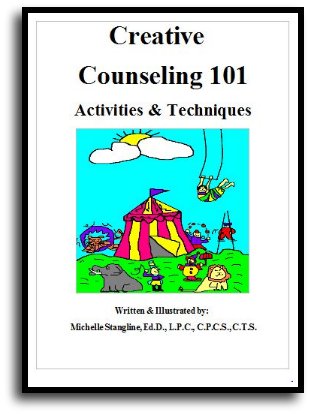
Step By Step Therapy:
Learn how to be a more Creative Therapist with the Book that started it all!
- Graduate School Counseling book used by hundreds of graduate counseling students!
- Includes full color reproducible worksheets with most activities.
- Winner of the Counselor Writer of the Year Award, 2011, Georgia Regional Award
Download Your Copy Today Only $39.95:
See Creative Counseling 101 eBook Information Here:
Get the Set
of all four
eBooks for only $98.95:
An incredible collection of how to do therapy eBooks!
A $159.80 Value,
You Save Over $60!
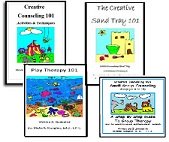
Get your complete set of the Creative Counseling 101.com eBooks by Dr. Michelle Stangline for only $98.95, that's less than $25.00 per eBook (Regular Price is $39.95 for each eBook.).
Your complete set includes:
- Creative Counseling 101
- Creative Group Counseling 101
- Creative Play Therapy 101
- Creative Sand Tray 101
For more information click the link below:
See Complete Set of eBooks For Sale Here:
New!!! "Beyond Art Therapy" 101 eBook
Over 300 pages of Beyond Art Therapy activities and techniques. Learn what I teach graduate counseling students!
See the link below for more information.
Only $39.95
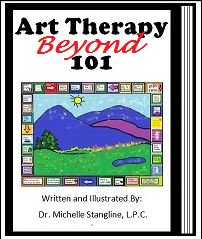
See More Invividual eBooks For Sale:
Sand Tray Therapy 101 eBook:
Learn how to do Sand Tray Therapy or enhance your skills.
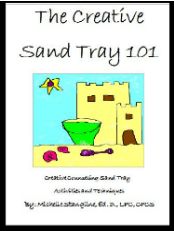
Play Therapy 101 eBook
Learn how to do play therapy or enhance your skills.
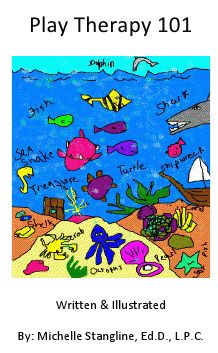
Small Group Counseling eBook For Sale:
Learn how to do creative group therapy and enhance your skills.
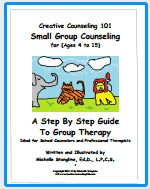
School Counselor Guidance Lesson & Social Stories eBook for sale:
Get a year's worth of school counselor guidance lessons with "Creative Warm & Fuzzy Classroom Guidance Lessons eBook". Introduce your students to the "Warm & Fuzzy Way". Click the link below for more information:
Warm & Fuzzy School Counselor Guidance Lessons eBook
